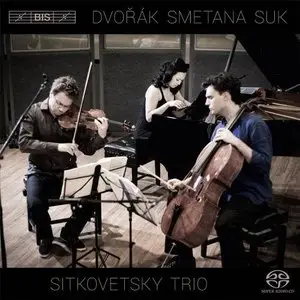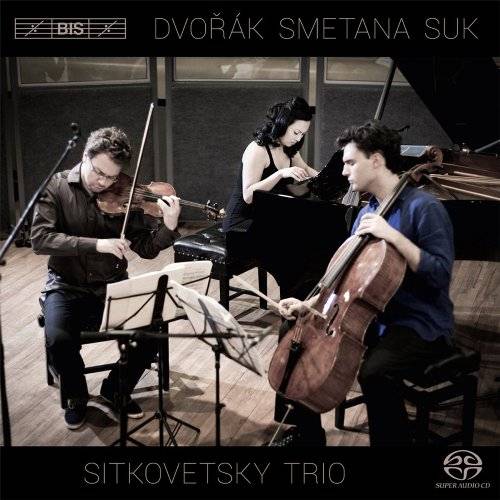Sitkovetsky Trio - Dvorak, Smetana, Suk: Piano Trios (2014)
EAC Rip | Flac (Tracks + cue + log) | 309 MB | MP3 320Kbps CBR | 173 MB | 1 CD | Full Scans
Genre: Classical | Label: Bis | Catalog Number: 2059
EAC Rip | Flac (Tracks + cue + log) | 309 MB | MP3 320Kbps CBR | 173 MB | 1 CD | Full Scans
Genre: Classical | Label: Bis | Catalog Number: 2059
The two large-scale works by Dvořák and Smetana are complemented here by the one- movement Elegy, by Josef Suk, Dvořák’s student and later son-in-law. Formed in 2007, the Sitkovetsky Trio performs worldwide and has received numerous awards and critical acclaim, but is here making its début on disc, in a programme perfectly suited to the ensemble’s virtuosic and impassioned music-making.
Composer: Antonín Dvorák, Bedrich Smetana, Josef Suk
Orchestra/Ensemble: Sitkovetsky Trio
Reviews: If you’ve not previously heard of the Sitkovetsky Trio, it’s because this is the ensemble’s recording debut. Formed in 2007 by three young musicians who met at Menuhin School in England, the group won first prize at the International Commerzbank Chamber Music Award just one year later, and then the NORDMETALL Chamber Music Award at the Mecklenburg Vorpommern Festival one year after that in 2009. The Trio takes the name of Alexander (Sasha) Sitkovetsky, the latest family member in a line of violinists; Dmitry is his uncle, and Julian, Dmitry’s father, shared competition prizes with Leonid Kogan and Igor Oistrakh. Sadly, Julian’s career ended prematurely when he died of lung cancer in 1958. The Sitkovetsky Trio’s other members are Leonard Elschenbroich (cello) and Wu Qian (piano).
For its first album, the ensemble has taken a rather daring risk in choosing two such well-explored works from the piano trio literature, works in particular that have received a number of quite recent critically acclaimed recordings. Though Dvorák’s F-Minor Trio and Smetana’s G-Minor Trio aren’t often paired together on the same disc, there have been some real standout recordings of each among new releases.
For example, only four issues back (37:4), I welcomed a release by the Trio Atanassov performing these same two trios in readings I felt distinguished themselves from the crowd by taking a more Classically oriented approach. In this issue, I was totally taken by another debut recording, this one by the Tempest Trio, performing Dvorák’s F-Minor and “Dumky” Trios on a Naxos CD. Not that long ago, in 35:4, I deemed the Weiss-Kaplan-Newman Trio’s release of Smetana’s Trio, coupled with Brahms’s B-Major Trio on Bridge, “a fabulous chamber music recording you cannot afford to be without.” And more recently, in 36:6, another Dvorák “Dumky” and Smetana coupling by the Benaud Trio on Melba earned my strongest recommendation.
Given the number and merit of the alternatives, one might say that the Sitkovetsky Trio made an injudicious programming choice for its debut album. Can these performances be any better, after all, than not a few others that have received the highest accolades? And even if they are better, how much better would they have to be to convince you to purchase yet another recording of Dvorák’s not-most-popular piano trio and Smetana’s Trio, which, in my opinion, is somewhat of an acquired taste?
Since defining terms like “better” and “best” with reference to musical performances is highly subjective and may ultimately be impossible, we tend to fall back on aspects of technical execution—tempo, dynamics, intonation, and so on—as calipers with which to measure the “goodness” of one performance in relation to another. But in this “golden age” of chamber music making, where new string quartet and piano trio ensembles seem to emerge in full shining glory, as if from a stellar nursery, even technical considerations lose their meaningfulness as measures of excellence, since perfection in matters of execution is now the new normal.
So what’s left in the critic’s toolbox to judge a performance other than his or her responses based on empiricism and intuition? Relying on those as guideposts, I can say that the Sitkovetsky Trio’s performances of these works are, if not in some tangible way, better than the others cited above, they are in every way their equals; and for reasons I can only vaguely apperceive, I like them more. I find a communicative expressiveness in the ensemble’s playing that speaks to me, personally, on an emotional level, such that I hear the music rather than the mechanics involved in the playing of it. But for those readers who insist on a breakdown of the components that go into these performances, here it is.
Sitkovetsky makes some of the most beautiful sounds I’ve yet to hear coming from a violin; his tone is of a sensuous allure that seduces with its nuanced textures and creamy smoothness. This is not the first time I’ve encountered him in a chamber music context; in 35:2, I reviewed a Brahms program on Onyx containing the composer’s String Quintet No. 2 and clarinet quintet in an arrangement of the clarinet part for viola. Sitkovetsky joined violist Maxim Rysanov in those performances, which earned my recommendation for the playing, though I was unconvinced by the viola transcription of the quintet. But this is the first time I’ve heard Sitkovetsky as exposed as he is in these trios, and his playing is pure gold.
I’ve also had the pleasure of encountering cellist Leonard Elschenbroich before, though tangentially, in my reviewing of Dmitri Kitaenko’s Tchaikovsky symphony cycle. Elschenbroich appeared on the Symphony No. 2 disc playing Tchaikovsky’s Rococo Variations . I judged his performance outstanding, but was critical of his choice of the Fitzenhagen hatchet-job version of the composer’s score. That aside, Elschenbroich, who plays the magnificent “Leonard Rose” cello by Venetian luthier Matteo Goffriller, produces a tone with the complex bouquet of a vintage port, and the rapport between him and Sitkovetsky is amazing. If you want to feel your heart melt, just listen to Sitkovetsky and Elschenbroich embrace and caress each other’s phrases in Josef Suk’s touching, tearful Elegy.
Not to leave Wu Qian out of the equation, she completes the ensemble in a way that contributes to one of the most integrated-sounding piano trios I’ve heard. Never dominant, as the pianist in piano trio scores often is, she is nonetheless the glue holding it together, and you feel that in her every rubato and gesture, whether poignant, poetic, or dramatic.
Last but far from least is BIS’s exceptional SACD recording, with the detail that emerges from the ensemble, the presence of the players, and the atmosphere surrounding them so real you can breathe it.
I began this review by questioning the Sitkovetsky Trio’s wisdom in programming works for its debut album so thoroughly explored on record by other ensembles, and I’m ending up seriously considering this disc as a candidate for my 2014 Want List. Even if you need a shoehorn to make room for this release on your shelf, I’d urge you to use one.
Tracklisting:
Antonín Dvořák (1841-1904)
[1]-[4] Piano Trio No. 3 in F minor, Op. 65 (1883)
Bedřich Smetana (1824–84)
[5]-[7] Piano Trio in G minor, Op. 15 (1855/58)
Josef Suk (1874–1935)
[8] Elegy for piano trio, Op. 23 (1902)
Exact Audio Copy V1.0 beta 3 from 29. August 2011
EAC extraction logfile from 9. March 2015, 2:17
Sitkovetsky Trio / Dvorak, Smetana, Suk - Piano Trios
Used drive : HL-DT-STDVDRAM GU70N Adapter: 0 ID: 0
Read mode : Secure
Utilize accurate stream : Yes
Defeat audio cache : Yes
Make use of C2 pointers : No
Read offset correction : 48
Overread into Lead-In and Lead-Out : No
Fill up missing offset samples with silence : Yes
Delete leading and trailing silent blocks : No
Null samples used in CRC calculations : Yes
Used interface : Native Win32 interface for Win NT & 2000
Used output format : User Defined Encoder
Selected bitrate : 128 kBit/s
Quality : High
Add ID3 tag : No
Command line compressor : C:\Program Files (x86)\Exact Audio Copy\Flac\flac.exe
Additional command line options : -V -8 -T "Date=%year%" -T "Genre=%genre%" %source%
TOC of the extracted CD
Track | Start | Length | Start sector | End sector
––––––––––––––––––––––––––––-
1 | 0:00.00 | 13:24.11 | 0 | 60310
2 | 13:24.11 | 6:32.43 | 60311 | 89753
3 | 19:56.54 | 10:35.58 | 89754 | 137436
4 | 30:32.37 | 9:13.37 | 137437 | 178948
5 | 39:45.74 | 10:42.54 | 178949 | 227152
6 | 50:28.53 | 7:33.18 | 227153 | 261145
7 | 58:01.71 | 8:23.22 | 261146 | 298892
8 | 66:25.18 | 6:45.70 | 298893 | 329337
Range status and errors
Selected range
Filename C:\temp\BIS-SACD-2059 - Dvorak, Smetana, Suk - Piano Trios\Dvorak, Smetana, Suk - Piano Trios.wav
Peak level 97.4 %
Extraction speed 5.4 X
Range quality 100.0 %
Test CRC F5113953
Copy CRC F5113953
Copy OK
No errors occurred
AccurateRip summary
Track 1 accurately ripped (confidence 2) [481B55E4] (AR v2)
Track 2 accurately ripped (confidence 2) [63FCCA51] (AR v2)
Track 3 accurately ripped (confidence 2) [24EBAB0A] (AR v2)
Track 4 accurately ripped (confidence 2) [1C3ACAF3] (AR v2)
Track 5 accurately ripped (confidence 2) [8A03A952] (AR v2)
Track 6 accurately ripped (confidence 2) [9C5DE91B] (AR v2)
Track 7 accurately ripped (confidence 2) [A1985726] (AR v2)
Track 8 accurately ripped (confidence 2) [CC84A18B] (AR v2)
All tracks accurately ripped
End of status report
==== Log checksum FD5CA3BDF3E2ED1320286C4A160965A7B3A34FEEF018EF84070F0DD3A5219231 ====
EAC extraction logfile from 9. March 2015, 2:17
Sitkovetsky Trio / Dvorak, Smetana, Suk - Piano Trios
Used drive : HL-DT-STDVDRAM GU70N Adapter: 0 ID: 0
Read mode : Secure
Utilize accurate stream : Yes
Defeat audio cache : Yes
Make use of C2 pointers : No
Read offset correction : 48
Overread into Lead-In and Lead-Out : No
Fill up missing offset samples with silence : Yes
Delete leading and trailing silent blocks : No
Null samples used in CRC calculations : Yes
Used interface : Native Win32 interface for Win NT & 2000
Used output format : User Defined Encoder
Selected bitrate : 128 kBit/s
Quality : High
Add ID3 tag : No
Command line compressor : C:\Program Files (x86)\Exact Audio Copy\Flac\flac.exe
Additional command line options : -V -8 -T "Date=%year%" -T "Genre=%genre%" %source%
TOC of the extracted CD
Track | Start | Length | Start sector | End sector
––––––––––––––––––––––––––––-
1 | 0:00.00 | 13:24.11 | 0 | 60310
2 | 13:24.11 | 6:32.43 | 60311 | 89753
3 | 19:56.54 | 10:35.58 | 89754 | 137436
4 | 30:32.37 | 9:13.37 | 137437 | 178948
5 | 39:45.74 | 10:42.54 | 178949 | 227152
6 | 50:28.53 | 7:33.18 | 227153 | 261145
7 | 58:01.71 | 8:23.22 | 261146 | 298892
8 | 66:25.18 | 6:45.70 | 298893 | 329337
Range status and errors
Selected range
Filename C:\temp\BIS-SACD-2059 - Dvorak, Smetana, Suk - Piano Trios\Dvorak, Smetana, Suk - Piano Trios.wav
Peak level 97.4 %
Extraction speed 5.4 X
Range quality 100.0 %
Test CRC F5113953
Copy CRC F5113953
Copy OK
No errors occurred
AccurateRip summary
Track 1 accurately ripped (confidence 2) [481B55E4] (AR v2)
Track 2 accurately ripped (confidence 2) [63FCCA51] (AR v2)
Track 3 accurately ripped (confidence 2) [24EBAB0A] (AR v2)
Track 4 accurately ripped (confidence 2) [1C3ACAF3] (AR v2)
Track 5 accurately ripped (confidence 2) [8A03A952] (AR v2)
Track 6 accurately ripped (confidence 2) [9C5DE91B] (AR v2)
Track 7 accurately ripped (confidence 2) [A1985726] (AR v2)
Track 8 accurately ripped (confidence 2) [CC84A18B] (AR v2)
All tracks accurately ripped
End of status report
==== Log checksum FD5CA3BDF3E2ED1320286C4A160965A7B3A34FEEF018EF84070F0DD3A5219231 ====
Thanks to the original releaser



